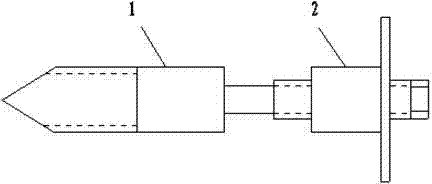Bidirectional forcing sleeve nail for restoration fixation
A technology of two-way pressurization and pressurized sleeves, applied in fixers, medical science, internal bone synthesis, etc., can solve problems such as fracture, lag screw fixation looseness, etc., to improve the quality of surgery, relieve pain, and improve treatment effects Effect
- Summary
- Abstract
- Description
- Claims
- Application Information
AI Technical Summary
Benefits of technology
Problems solved by technology
Method used
Image
Examples
Embodiment Construction
[0017] The invention consists of two parts: a bidirectional screw 1 and a compression sleeve 2.
[0018] figure 1 , 2 It is shown that the screw of the two-way screw 1 is a variable-diameter screw. The diameter of the front screw 3 of the two-way screw 1 is larger than the diameter of the rear screw 4. There are threads on the front screw 3 and the rear screw 4, respectively. The tail end is an outer hexagon structure 5.
[0019] figure 1 , 2 It is shown that the length of the front screw 3 of the bidirectional screw 1 is 0.5-0.75 of the full length of the screw, and the length of the rear screw 4 is 0.25-0.50 of the full length of the screw.
[0020] figure 1 , 2 It is shown that the thread length of the rear screw 4 of the bidirectional screw 1 is the entire length of the rear screw 4 or 1 / 2-2 / 3 of the rear screw 4, and the unthreaded section is located at the connection with the front screw 3.
[0021] figure 1 , 2 It is shown that the rear screw 4 of the two-way screw 1 has a thre...
PUM
 Login to View More
Login to View More Abstract
Description
Claims
Application Information
 Login to View More
Login to View More - R&D Engineer
- R&D Manager
- IP Professional
- Industry Leading Data Capabilities
- Powerful AI technology
- Patent DNA Extraction
Browse by: Latest US Patents, China's latest patents, Technical Efficacy Thesaurus, Application Domain, Technology Topic, Popular Technical Reports.
© 2024 PatSnap. All rights reserved.Legal|Privacy policy|Modern Slavery Act Transparency Statement|Sitemap|About US| Contact US: help@patsnap.com










